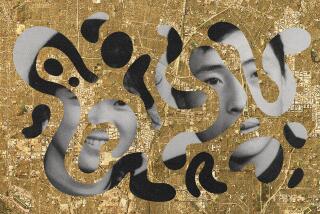Indians ‘Throw Color’ in Springtime Rite
- Share via
More than 200 Indians gathered in Thousand Oaks Sunday to celebrate the ancient springtime festival of Holi, a Mardi Gras-like affair featuring heaps of spicy Indian food, traditional music and folk dances.
“The main thing is to eat and have fun, that’s the number one priority,” said Rajeshwar Sahai, an electrical engineer from Thousand Oaks. “The next thing is to eat and have more fun.”
The colorful festival--which is celebrated by both Hindus and Sikhs--marks the beginning of spring, the end of the winter harvest and an Indian legend in which truth triumphs over evil. And its celebration drew Indians from around Ventura County to the Conejo Valley Park Community Center in a whirl of folk costumes, music and the “throwing of color”--the painting of friends’ faces to symbolize warm feelings.
Outside the center, soundtrack music from popular Indian movies drifted over dozens of Little League players gathered in the park for a more traditional American rite of spring--baseball.
The celebration was organized by members of the India Cultural Society, who said they want their children to know both the culture of America, where many of them were born, and that of India, where many of their parents were born.
The society was formed in 1977, and the first Holi festival in Ventura County was held four years ago, members said.
Society president Manmohan Mittal said there are 108 families in the group, who pay an annual membership fee of $15. Most of the members live in Thousand Oaks, Simi Valley, Westlake Village, Camarillo and Oxnard, he said.
At more than a dozen stalls set up in the center’s main hall, there was a bounty of spicy, home-cooked Indian foods. Among them were samosa , a kind of turnover stuffed with curried potatoes and peas, and dosai , a fluffy, pancake-like mass of fermented rice and lentils stuffed with curried potatoes and spices and served with a coconut-based sauce.
Among the desserts was barfi , a rich pastry made of milk and ground pistachios and topped with a thin layer of edible silver hammered into thin leaves, which Indians consider a delicacy.
In India, Mittal said, “everybody goes into the streets, into friends’ homes to eat sweets and to throw water scented with flowers and sweet spices on one another. You hug everybody, even your enemies.”
In part, Holi is based on an Indian myth, society members said. A king named Kashiayab exhorted his people to worship him above all others, but his son, Prahlada, worshiped the true god. When Prahlada could not be dissuaded from his beliefs, the king conspired with his sister Holika to kill him.
Believing that evil spirits would protect her, Holika climbed onto a bonfire with Prahlada. He lived but she perished, symbolizing truth’s victory over evil.
“It’s because of that story, because the people were happy, that we are getting together,” said Rajni Narayan of Westlake Village. “In this country, this is our family,” she said. “Whenever we need help, these are the people who help us. It’s a close-knit community.”
More to Read
Sign up for Essential California
The most important California stories and recommendations in your inbox every morning.
You may occasionally receive promotional content from the Los Angeles Times.













